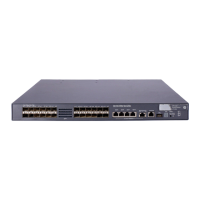236
Outputting system information to the trap buffer
NOTE:
The trap buffer only receives the trap information, and discards the log and debugging information
even if you have configured to output them to the trap buffer.
To do… Use the command… Remarks
1. Enter system view.
system-view —
2. Enable information center.
info-center enable
Optional.
Enabled by default.
3. Name the channel with a
specified channel number.
info-center channel channel-
number name channel-name
Optional.
See Table 9 for
default channel
names.
4. Configure the channel through
which system information can
be output to the trap buffer
and specify the buffer size.
info-center trapbuffer [ channel
{ channel-number | channel-
name } | size buffersize ] *
Optional.
By default, system information is
output to the trap buffer through
channel 3 (trapbuffer) and the
default buffer size is 256.
5. Configure the output rules of
the system information.
info-center source { module-name
| default } channel { channel-
number | channel-name } [ debug
{ level severity | state state } * |
log { level severity | state state } *
| trap { level severity | state
state } * ] *
Optional.
See “Default output rules of
system informat
ion.”
6. Configure the format of the
time stamp.
info-center timestamp { debugging
| log | trap } { boot | date |
none }
Optional.
The time stamp format for log,
trap and debugging information
is date by default.
Outputting system information to the log buffer
You can configure the device to output log, trap, and debugging information to the log buffer, but the
log buffer only receives the log and debugging information, and discards the trap information.
To do… Use the command… Remarks
1. Enter system view.
system-view —
2. Enable information center.
info-center enable
Optional.
Enabled by default.
3. Name the channel with a
specified channel number.
info-center channel channel-
number name channel-name
Optional.
See Table 9 for
default channel
names.

